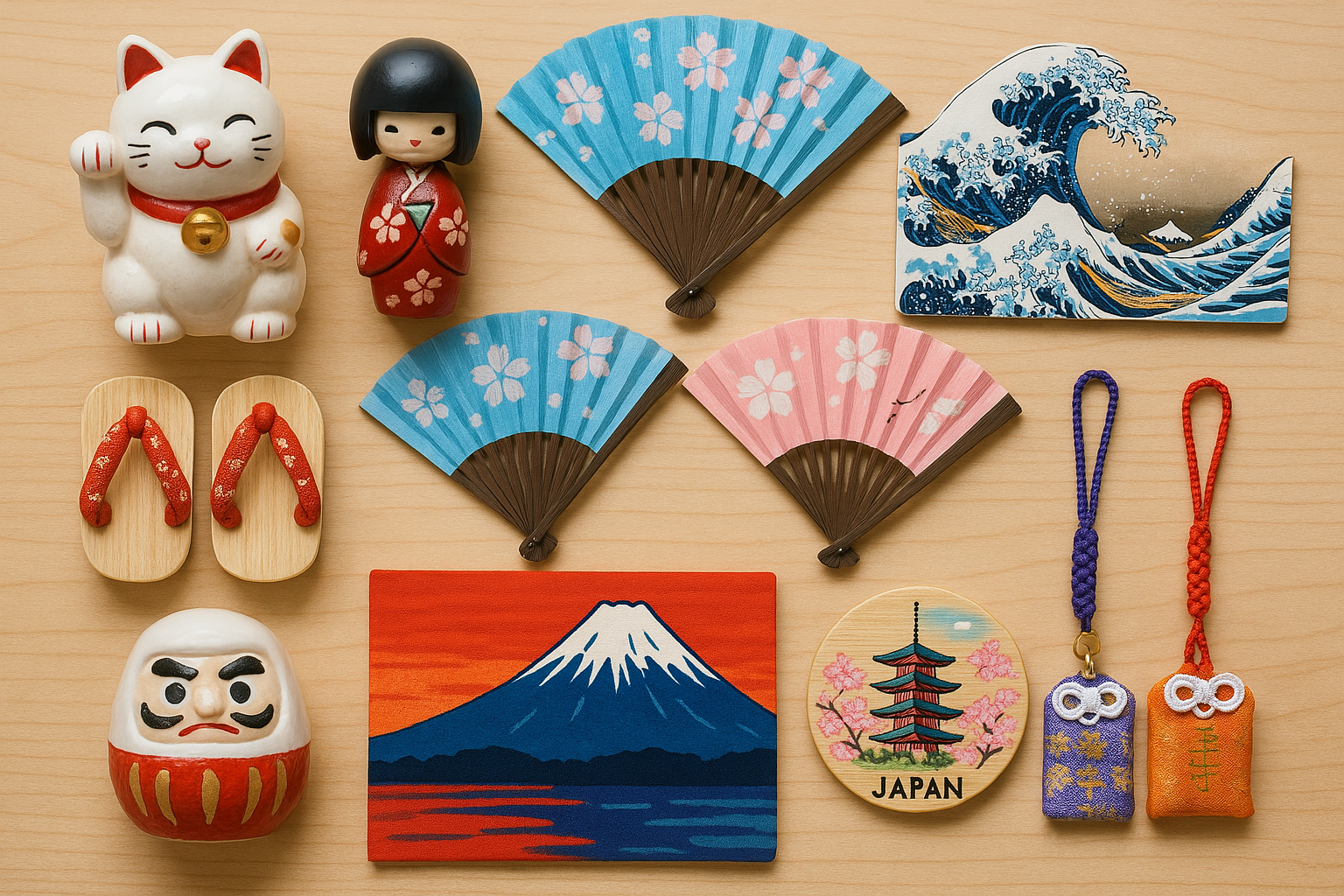Top 10 Japanese Cultural Souvenirs You Shouldn’t Miss in Japan: Must-Have Treasures for an Unforgettable Trip!
Why Japanese Souvenirs Are So Special
Japanese souvenirs are much more than mere trinkets; they are a piece of the country’s soul. Japan is known for its deep-rooted cultural traditions, and the items you bring home reflect centuries of artistry, craftsmanship, and spiritual meaning. When you pick out a souvenir here, it’s like bringing a bit of Japan’s history and character back with you. The creativity and attention to detail in Japanese craftsmanship are what truly set these souvenirs apart from those you find elsewhere in the world. Trust me, when you give or receive a Japanese souvenir, it’s an experience in itself, one that tells a story and offers a glimpse into the heart of this fascinating culture.
1. Traditional Japanese Tea Sets
Why You Should Bring Home a Tea Set
If you’ve ever enjoyed a cup of Japanese green tea, you know that it’s not just about the taste—it’s a full sensory experience. The way the tea looks, the way the pot feels in your hands, and the way it all comes together make it a ritual that’s been perfected over generations. A Japanese tea set is more than just functional; it’s a piece of art. Imagine sipping tea from a beautifully crafted ceramic cup or presenting guests with tea in a stunning Kyusu (Japanese teapot). It’s a perfect souvenir for anyone who appreciates tea culture or simply wants a piece of Japanese tradition in their home.
Types of Tea Sets
There are various types of tea sets you can choose from depending on your personal taste. For instance, the traditional Kyusu teapot is ideal for brewing Japanese green tea, while Matcha bowls, used in tea ceremonies, make for a stunning addition to any collection. You can even find hand-painted teacups that feature delicate floral patterns or traditional Japanese motifs. The more intricate the design, the more it reflects the craftsmanship behind it. When picking your tea set, think about how it will make you feel every time you use it, bringing you closer to the calming experience of tea time in Japan.
Where to Buy Them
Some of the best tea sets can be found in Kyoto, the heart of traditional Japanese culture. Shops like Ippodo Tea in Kyoto specialize in both high-quality tea and tea sets. If you’re in Tokyo, head to Asakusa, where you can find elegant tea sets in local stores or at department stores such as Mitsukoshi and Takashimaya. Wherever you go, make sure to look for authenticity and handcraftsmanship, as these qualities ensure that you’re bringing home something truly unique.
2. Kimono and Yukata
The Charm of Wearing Traditional Japanese Garments
Kimono and Yukata are perhaps the most iconic symbols of Japanese culture. Imagine yourself walking through the streets of Kyoto in a beautiful Kimono, or attending a summer festival in a light, colorful Yukata. These garments are more than just clothing; they represent the elegance, tradition, and artistry of Japan. A Kimono’s intricate patterns, vibrant colors, and detailed craftsmanship are simply breathtaking. Yukata, on the other hand, are more casual and often worn in warmer weather, making them a lighter option for those who want to take a piece of Japan’s sartorial history home.
How to Choose the Right Kimono or Yukata
Choosing the right Kimono or Yukata can be a bit overwhelming given the variety of designs and materials. Kimono are traditionally made from silk, while Yukata are generally made of cotton, which makes them more breathable and comfortable for casual wear. When shopping for a Kimono, look for elegant floral or nature-inspired patterns, which symbolize various seasons or festivals. Yukata, on the other hand, come in brighter, more playful designs and are often worn during summer festivals like Obon or Tanabata. It’s not just about picking one that looks beautiful, but one that aligns with the season or occasion you want to commemorate.
Where to Find Authentic Kimono
Kyoto is the perfect place to purchase traditional Kimono, with many small shops in the Gion district offering rental services as well. If you prefer something more casual, Yukata are available in department stores like Mitsukoshi in Tokyo. They also offer beautiful sets with everything you need, including an obi (sash) and accessories. Don’t forget to ask the store staff for tips on how to wear and care for your Kimono or Yukata to ensure it lasts for generations!
3. Japanese Fans (Uchiwa and Sensu)
Why Japanese Fans Are a Perfect Souvenir
Fans have been an integral part of Japanese culture for centuries. Whether you’re looking for something decorative or functional, Japanese fans are the perfect souvenir to bring home. There’s something magical about how the folding Sensu fan or the flat Uchiwa fan can evoke feelings of coolness on a hot day, yet at the same time, they’re works of art. From traditional paintings on Sensu fans to intricate patterns on Uchiwa, these fans add a beautiful touch of Japanese craftsmanship to any room. Plus, they make for easy-to-pack, lightweight souvenirs that you can display or use on a hot day!
Different Types of Japanese Fans
The two most common types of fans in Japan are Uchiwa (flat fans) and Sensu (folding fans). Uchiwa fans are typically used for cooling off during hot summer days or in festivals, while Sensu fans are used in traditional Japanese dance and tea ceremonies. Uchiwa fans often feature large, colorful designs of flowers, animals, or seasonal motifs, while Sensu fans have a more delicate folding design that often includes intricate art or calligraphy. They’re both symbolic and practical, and picking one will depend on whether you’re looking for a decorative item or something to use in daily life.
Best Places to Buy Fans
The best fans are typically sold in places like the Gion district in Kyoto, where you can find artisans hand-making these traditional items. Additionally, the Asakusa district in Tokyo, near the famous Sensoji Temple, offers a variety of hand-crafted fans in various designs. Keep an eye out for limited-edition pieces that feature rare or custom designs. You’ll feel the effort and artistry that went into creating each fan!
4. Japanese Ceramics and Pottery
The Craftsmanship Behind Japanese Pottery
Japanese pottery is renowned around the world for its delicate beauty and timeless elegance. The centuries-old tradition of pottery-making in Japan has evolved into a fine art, with different regions specializing in unique styles. From rustic, earthy hues of Iga pottery to the polished elegance of Arita porcelain, Japanese ceramics offer a wealth of variety for collectors and home decorators alike. The charm of Japanese pottery is that no two pieces are ever the same—each one is an expression of the artisan’s creativity and skill.
Popular Pottery Regions
Japan boasts several pottery regions that produce distinct styles. Arita in Kyushu is famous for its fine porcelain, known for its bright white finish and delicate designs. Meanwhile, Mashiko in Tochigi Prefecture is known for rustic, earthy pottery that reflects a more traditional, handmade style. If you’re in Kyoto, check out the Kiyomizu pottery, renowned for its elegant, refined aesthetics. Each region offers a different flavor of Japanese pottery, making it easy to find the perfect souvenir that resonates with you.
How to Spot High-Quality Ceramics
When shopping for Japanese ceramics, it’s essential to look for signs of craftsmanship. The most refined pieces often have a smooth glaze, perfect symmetry, and delicate hand-painted designs. A high-quality ceramic piece should feel balanced and sturdy. While imperfections in handmade pottery add character, ensure that any cracks or chips are intentional rather than a flaw in craftsmanship. Local pottery shops and even the markets of Kyoto offer a wide range of options where you can personally inspect the beauty of these works of art.
5. Maneki Neko (Lucky Cat)
What the Maneki Neko Represents
The Maneki Neko, or “beckoning cat,” is one of Japan’s most recognized symbols of good luck. Often seen in restaurants, shops, and homes, this charming feline is believed to bring prosperity and success to its owner. The cat’s raised paw is a gesture inviting good fortune, and depending on which paw is raised, it symbolizes different types of luck. It’s no wonder this lucky charm has become one of the most popular souvenirs for tourists visiting Japan!
Types of Maneki Neko
The Maneki Neko comes in different colors, each representing different kinds of luck. A gold Maneki Neko is said to bring wealth and prosperity, while a white one brings purity and happiness. You might also find black Maneki Neko, which is believed to ward off evil spirits, and green Maneki Neko, which offers protection for travelers. The raised paw—left or right—also symbolizes specific kinds of fortune, with the left paw attracting customers and the right paw bringing financial success.
Where to Buy Maneki Neko
Maneki Neko can be found at nearly every souvenir shop in Japan, especially in tourist-heavy areas like Tokyo’s Asakusa and Kyoto’s Gion district. The Sensoji Temple in Asakusa is famous for selling these iconic lucky cats, often in various colors and sizes. Many shops also offer custom-made versions where you can pick your preferred color and paw position, adding a personal touch to your good-luck charm.






コメント